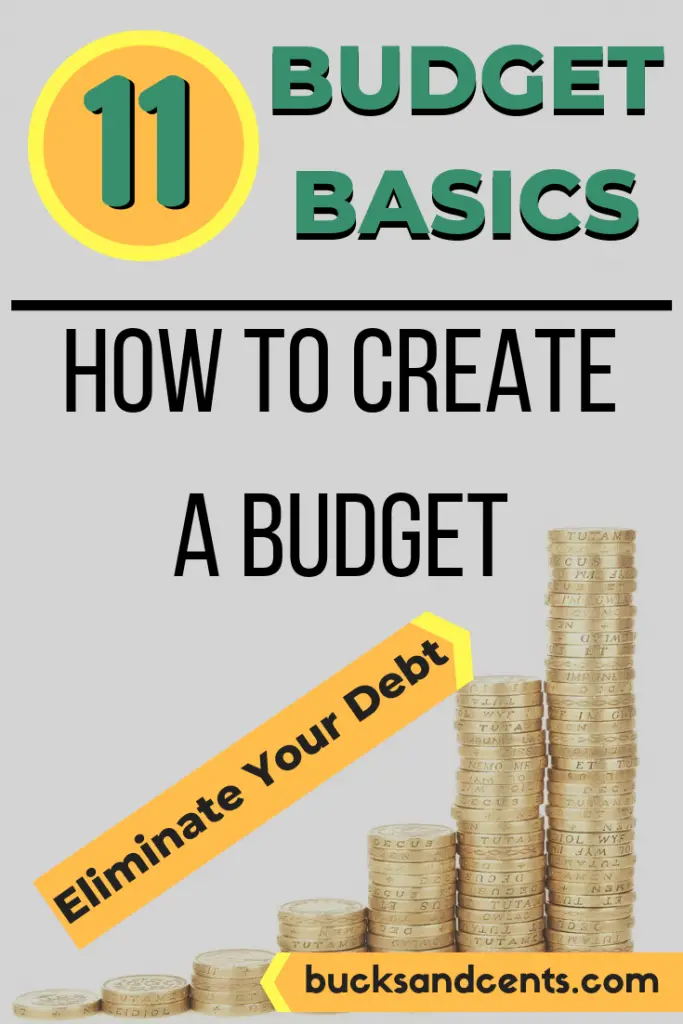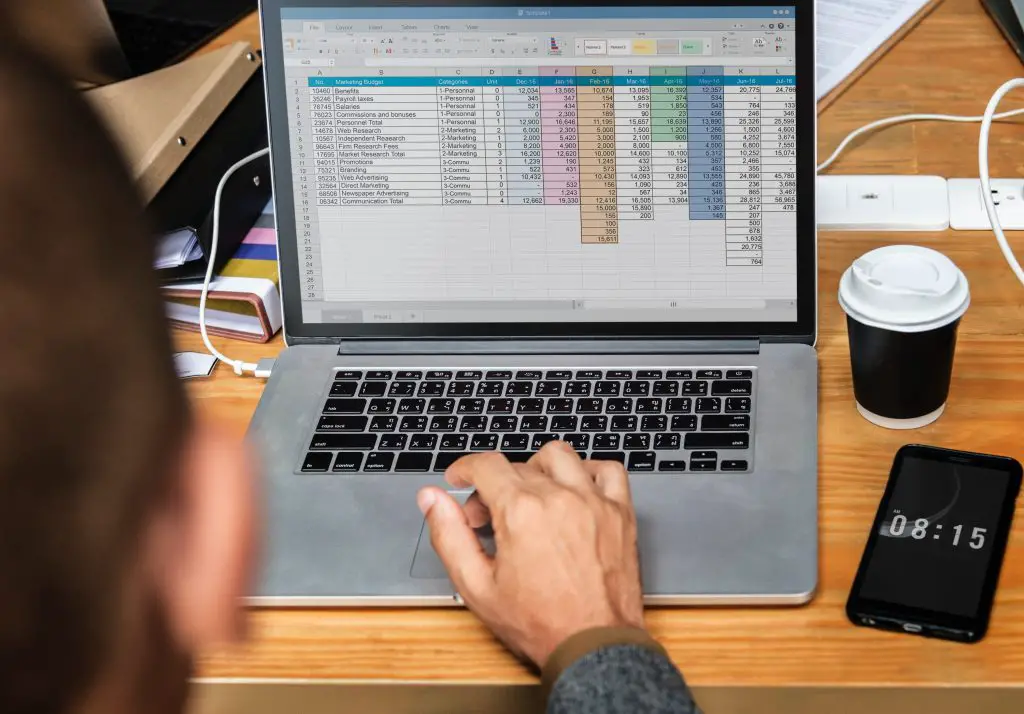Learning the steps how to create your own monthly budget is one of the necessary pillars for achieving financial independence.
While there are many aspects to budgeting and budgeting methods, the first step is to create your own monthly budget for all of them.
Think of a budget as the road map that you will use to get to your financial destination. Using a budget is also a necessary tool for using a personal finance flowchart and it can also be applied to all budgeting methods.
You can travel on many different types of roads (or budgeting methods), but you need a map (a budget) for all of them to get to your end destination. Creating a budget is essential to achieving your financial goals and is essential for how to teach teens about financial responsibility in their life.
Below are the steps necessary for how to create a monthly budget.
Calculate Monthly Income
One of the first things you should determine when you create a budget is how much available monthly income you have. This is one of the most elementary lessons of your budget.
Now you may have several side hustles or part time jobs that you are working. Additionally, you might be self employed and your household budget may be based on very irregular income.
When I was side hustling, what I learned side hustling definitely changed my opinion on part time income.
You have a choice to make here with regard to all of your side hustling and part time income.
If you want to base your income off of your steady employment source, then only use that amount as your monthly income.
This is a good policy to follow because additional income such as side hustles or secondary jobs may only be temporary. Therefore you may not want to consider it as part of your permanent income source.
If you think that your part time income or income from other jobs and side hustles is permanent, then you can include it as part of your monthly income.
- What about lump sum payments, bonuses, or one time payments made within a year?
You will have to decide if you want to include those amounts as well as part of your income stream.
While it will be difficult to calculate this income monthly since it is sporadic, you can keep track of this on an annual basis. You can account for it that way within your budget model when you budget your money.
Calculate Your Fixed Monthly Expenses
List all of your fixed monthly expenses and write them down. These are expenses that you have every month where the totals do not change and they should be included when you create a budget. If you are trying to repair your credit yourself, knowing your monthly expenses is an important step.
They would include things such as:
- your mortgage payment or rent
- internet
- student loans
- car payments
- credit card payments
You would also want to include credit card payments. If you have credit card debt and you are making a monthly payment to a credit card company, include that amount. This would be considered a fixed expense that you have every month.
Even if you are just making the minimum monthly payment, you should still include it as a fixed expense.
- What about if you have different amounts each month for things such as groceries, transportation costs, or buying clothes?
No problem. These are often referred to as variable expenses. They are called variable because they have different totals each month. We will cover these items down below.
- So how can you account for that?
Simply take a three-month average of those expenses and use that amount as the total.
- What about one time only expenses per year?
An example of this could be paying your life insurance premium if you don’t have any offered through your employer.
Divide the cost over a 12 month period and be sure to include that in your spreadsheet and budget. Make sure you save this money however and don’t spend it if you are choosing to pay it in full one time a year.
If you choose to make monthly payments be sure to send them in to the insurance company each month.
However you decide to pay it, make sure that you adjust your spreadsheet.
Chart Your Path and Set Financial Goals
In the previous steps we set the groundwork for our household budget strategy and determined our income and also what are fixed expenses are. The step takes a little bit of thought and reflection.
You will need to prioritize what is important in your financial life.
- What do you want to accomplish?
- Is it to attain financial freedom?
- When reflecting on your life, what is the one thing that will make your life great?
- What will bring happiness to your life and make your life less stressful?
- To have have more discretionary money?
- To spend the time with your family?
- Maybe saving for retirement?
- Being able to take your family on vacations?
- Reducing debt?
Once you have figured out what goals are important to you and your family, include them as part of your monthly fixed expenses. You will want to make these items part of your monthly budget.
Essentially you will want to contribute some type of dollar amount every month towards these goals.
Determine Your Variable Expenses
These expenses are often called non-discretionary. Although I consider them more as variable expenses. These would include things such as utilities, groceries, and transportation costs.
You have these fixed expenses every month, however the total is not exactly the same every month. It varies month-to-month.
So what you have to do when you are creating a budget is use budgetary guidelines and take the last three or four months and average those totals.
For example, if you spend $200 on food one month, 300 the next, and $100 on the third month you need to average those amounts. The monthly amount you should use for groceries would be $200 a month in your budget forecast.
Determine Your Discretionary Expenses
Take a look at all of your discretionary expenses that you have each month. These would include things such as going out to eat, seeing a movie or play, or maybe taking a weekend trip out of town.
Other things that may be included in this category when you create your own monthly budget would be shopping or making impulse purchases. Look at the last couple months of expense history and see if you have these type of expenses.
Did you buy things that you really did not need? If so write those totals down and what they were and where the purchase was made.
Some of your purchases might be on a credit card and you may no longer use those items. You can cancel those transactions. Check out will canceling a credit card stop recurring payments?
Use a Ranking System For Discretionary Expenses
After you have all your discretionary expenses listed, they need to be ranked. Figure out which was the most important discretionary expense for you.
- What is it going to the movies?
- Maybe it was going out to eat?
- Purchasing a new comforter last month?
Perhaps you could have done without purchasing that new comforter set last month. All of your discretionary expenses should be prioritized.
Budget Reductions on Discretionary Expenses
This is probably the hardest step to do when it comes to creating a budget. Reducing discretionary expenses is where the rubber meets the road in personal finance and budgeting. In order to get out of debt, there has to be reduced expenses. Nobody ever wants to make reductions or cut things out of their life.
The truth is there is a lot of psychology that goes into non-discretionary purchases that are made.
A lot of times people use shopping as a way to bring them happiness. Whatever rough patch they may be going through in their life, they may use shopping as a coping mechanism.
When in reality, impulse shopping is really a short-term fix and has the capability to create catastrophic financial results.
Often times, people accumulate massive amounts of debt through discretionary purchasing and shopping. It can be bad for a persons health and also their wallet.
It is always hard to change repetitive habits and patterns.
However keep in mind that you are doing this to achieve your goals.
In theory the goals that you listed should be much more important than the discretionary expenses you made over the last few months. If you are fully committed to achieving your goals that you listed, then this step is actionable and doable.
Analyze Your Expenses and Income
This is where you will have to get your calculator out or use a budget template spreadsheet. The goal of this step is to capture what the dollar amount is each month for discretionary expenses and redirect it.
Determine how much your salary is per hour and convert it into monthly income. For example $40,000 is how much an hour. Take a moment to go over and review your prioritized ranking list that you just created for your discretionary expenses. Start at the bottom of that list, in other words at the lowest priority, for your analysis.
Starting from the bottom, determine how many of those items you can live without.
- Can you live with going out to eat?
- Are you able to skip going to the movies?
- Can you live without going out of town?
- Can you live without your gym membership?
There is no right or wrong answer here and what you decide to do without will be very different from somebody else and their values and opinions.
If you have decided to eliminate the last four monthly discretionary expenses, be sure that you don’t include those going forward as monthly expenses.

Whatever items and amounts you end up eliminating from discretionary expenses they will no longer be included in your new budget you are creating.
At the end of this step, you should be left with overall totals of what your monthly fixed expenses are and what your monthly income is. You should have a budget surplus. If you don’t, you will have to go back through your discretionary expenses and think about eliminating additional items.
The goal is to have a budget surplus at this stage.
If you don’t have any additional money available, you won’t be able to achieve your financial goals that you wrote down.
Reallocate Surplus
As you work through to create your own monthly budget, you will have to reallocate the surplus. You should have more income available then expenses at this point.
Take this additional income that you have and allocate it towards your savings goals that you created earlier.
You can do this in a couple ways:
- Allocate all surplus money and allocate it towards the one goal that is most important for you.
- You can use the same ranking strategy for your goals that you used for your discretionary expenses.
Use this ranking system for your goals to determine which is the most important to you.
- Allocate all surplus money and split it in different ratios and contribute something towards all of your goals every month.
If the goals are equally important to you, this is a good strategy to use.
- Allocate all surplus money in addition to your bonuses and one time only money.
Remember that extra money that you received once a year?
Maybe you want to take that income and put all of that towards one of your goals in addition to all of your surplus income.
As you can see there are countless combinations on how to allocate your surplus money towards your goals.
Whatever you decide, the most important thing is knowing that you now have extra income available to put towards your goals.
Monitor Your Budget
Congratulations you have made all of the necessary changes and sacrifices to achieve your goals! At the end of each month, take the time to review your budget. See what budgeting tips you have realized.
Take a look at all of your expenses for the month and compare them to months past.
- Did you have more expenses?
- Or were they slightly less?
- Did you have any emergency expenses that had to be made?
- Do you see any trends developing over the past couple months in regards to expenses?
There are a lot of advantages to budgeting your money such as conclusions that can be drawn from your monthly budget. That’s why it is so important to always review everything at the end of each month. The best approach is a hands on approach an active monitoring of your financial situation and your budget.

Recapture Variable Savings
When you create your own monthly budget and relying mainly on a fixed expenses in your budget, you still will have some variables every month. Things like utilities and transportation costs while they are considered fixed expenses, the amount does vary every month.
While this money in savings will be relatively small in the grand scheme of your monthly budget, it still serves a purpose. Instead of committing it towards one of your goals, there is another purpose for this money.
Another thing you can do with this left over money is to set up something called a personal rainy day fund which will help you budget more efficiently.
It’s good to have an emergency savings account because there will be times when you have one time emergency expenses that will come up.
If you have an account like the set up you can draw from this money as it is available money.
You will save yourself a lot of stress if you have a car repair expense that is coming and are fortunate to have additional money set-aside that is dedicated for this purpose.
By having a savings fund like this, you are already taking the steps to plan for emergencies that may occur.
It’s an extremely efficient way to budget.
Creating a Budget Summary
Creating a budget and achieving your goals does not have to be difficult or impossible. Following these 11 steps above will put you on the path to success. Nearly one third of all millennials are excited and inspired when it comes to financial planning.
However, by going through the process of learning how to create your own monthly budget, you are taking the first step in achieving your goals.
And once you achieve your goals, all the sacrifices you have made we will come to realize that they were all worthwhile.




Leave a Reply